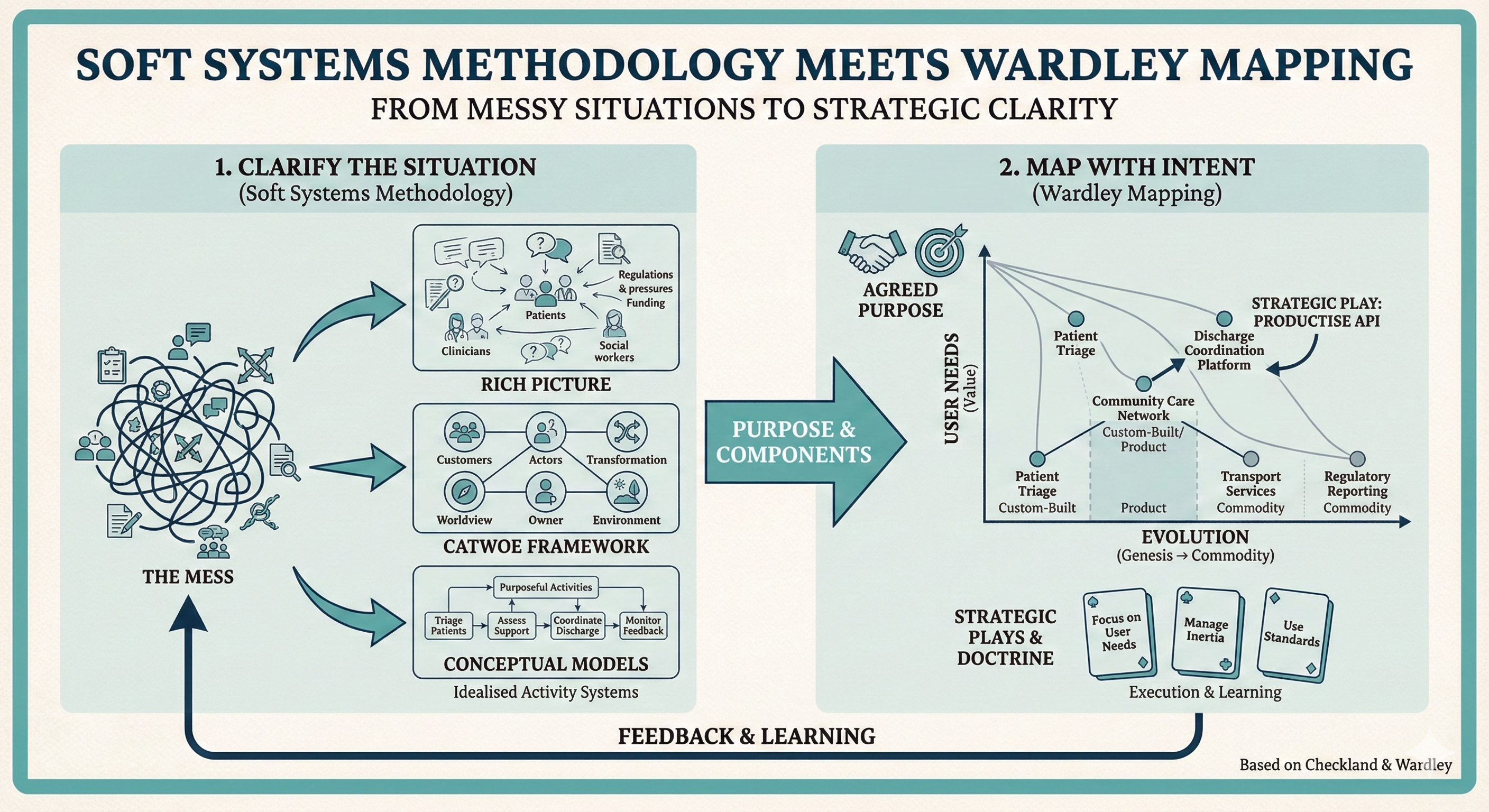Soft Systems Methodology Meets Wardley Mapping
In our last post, we explored how double-loop learning keeps Wardley Maps honest by forcing us to question the assumptions and frames that underpin our maps. But what happens when a problem is so messy and contested that we can't even agree on a starting point for the map?
Pairing Soft Systems Methodology (SSM)—Peter Checkland’s approach for exploring messy situations through multiple worldviews—with Wardley Mapping gives leaders a disciplined way to explore these situations, negotiate a shared worldview, and only then convert that clarity into the structure of a map. SSM makes space for conflicting narratives and hidden assumptions, while Wardley Maps translate an agreed purpose into visible components, evolution, and strategic plays. Together, they form a loop: learn the situation, model a purposeful change, map what needs to exist, and then test your strategy against reality.

Why Bring SSM into Wardley Mapping?
Wardley Maps work best when the team already agrees on who the users are, what they need, and the value chain that delivers it. But in the early stages of strategy, stakeholders often disagree on the nature of the problem, the scope of the system, or which constraints are real. This ambiguity can cause chaos during mapping sessions: conversations stall over definitions, politically sensitive components are hidden, and the map fractures into conflicting views.
Peter Checkland's Soft Systems Methodology treats that ambiguity as the main task. It invites multiple perspectives, brings conflicting worldviews to the surface, and builds conceptual models to describe how a system could operate under each worldview. When participants compare these models with the real situation, they can negotiate changes that are both feasible and desirable. Only after this learning cycle can a Wardley Map hope to represent a landscape that everyone is prepared to act on.
In practice, SSM provides three benefits before you even draw the first axis of a map:
- Shared context: 'Rich pictures' and interviews create a narrative that reveals user needs, conflicts, and environmental factors without forcing agreement too early.
- Purposeful boundaries: The 'CATWOE' framework helps to define what "the system" is for, who benefits or suffers from it, and what constraints matter. This gives Wardley Mapping a clear customer, need, and owner to anchor to.
- Hypotheses for change: Conceptual models of activity show which transformations might improve the situation. They provide the initial components for the map and highlight where your doctrine will be tested.
Running the Combined Loop
Treat SSM and Wardley Mapping as alternating between the messy reality of the situation and the structured world of strategy.
1. Understand the Situation with SSM Tools
Begin with interviews, observations, and reviewing documents. Encourage stakeholders to sketch 'rich pictures' that capture the key actors, information flows, tensions, and external pressures. Don't worry about the axes of a map yet; the goal is to bring out the different stories about what is happening and why it matters.
2. Draft Root Definitions with CATWOE
For each perspective you uncover, work with the group to write a 'root definition' that captures the purposeful system they believe would improve the situation. Explicitly note the Customers, Actors, Transformation, Worldview, Owner, and Environmental constraints (CATWOE). These statements are hypotheses about the system you will later map: they tell you whose needs to prioritise and which constraints the map must respect.
3. Build Conceptual Activity Models
Translate each root definition into a simple conceptual model—five to seven activities that would have to happen if that worldview were a reality. These are not flowcharts of the current organisation; they are idealised descriptions of how the purposeful system would operate. Compare these models with reality, highlight the gaps, and discuss which changes seem both desirable and culturally feasible.
4. Switch to Wardley Mapping When a Purpose Is Agreed
Once the group agrees on a shared—or at least negotiated—purpose, summarise the agreed-upon users, needs, and transformation activities. Use this as the 'north star' for your Wardley Map. The components in your conceptual models are the initial candidates for the value chain. Their placement on the evolution axis will come from the evidence you gathered during the SSM conversations: Which components are new experiments? Which are already commodities you depend on? Which components cause political tension because they challenge someone’s worldview?
5. Feed Map Insights Back into SSM Discussions
After drafting the map, return to the SSM loop. Ask: Does the map honour the root definitions? Are any CATWOE elements missing? Do the conceptual models suggest strategic plays you have ignored? Iterate between adjusting the map and debating in the SSM framework until the team believes the map represents both the reality of the situation and the purposeful change they want to make.
Complementary Strengths
| Aspect | Soft Systems Methodology | Wardley Mapping | Combined Effect |
|---|---|---|---|
| Problem definition | Embraces multiple, conflicting problem framings and treats them as legitimate through rich pictures and discussion. | Assumes a coherent description of users and their needs to anchor the map. | SSM clarifies the problem space, so the map reflects a negotiated intent rather than just the loudest voice. |
| Stakeholder alignment | Facilitates dialogue and makes underlying worldviews explicit through CATWOE. | Visualises dependencies and inertia, encouraging evidence-based debate. | Together, they align both the narrative and the structural understanding of the situation. |
| Action design | Conceptual activity models explore how purposeful systems might operate. | Doctrine and climatic patterns highlight strategic plays that are appropriate to a component's evolution. | Conceptual models inform which strategic moves to test; the map shows where to act. |
| Learning loops | Iterative comparison between models and reality brings feasible changes to the surface. | Mapping sessions reveal component evolution, inertia, and competitive pressure. | Alternating between them builds a learning system that updates both the worldview and the map of the landscape. |
When to Lead with SSM and When to Lead with Mapping
- High ambiguity, low agreement: Start with SSM. When teams can't agree on the purpose of a change or argue over the definition of "the user," stay in the rich-picture and root-definition phases until you have language everyone can accept.
- Clear purpose, unclear landscape: Start with mapping. If the problem statement is stable but you lack visibility into the components, their evolution, or your competitors' positions, draw the map first and use SSM later to explore contested issues of governance or adoption.
- Complex ecosystems: Use both. Multi-party ecosystems (like public services, supply chains, or cross-sector partnerships) benefit from SSM's ability to legitimise different worldviews. Once you have at least a shared goal for transformation, Wardley Mapping can expose leverage points and highlight where cooperation, standards, or managed inertia will be important.
Practical Facilitation Tips
- Stage the workshops: Run an SSM session focused on rich pictures and CATWOE before a mapping workshop. Share the outputs in advance so participants arrive ready to place components rather than argue over definitions.
- Annotate the map with SSM insights: Mark components with the worldview or stakeholder that values them most. This preserves the diversity of perspectives that SSM surfaced and reminds the team whose needs are at stake during strategic discussions.
- Use conceptual activities as map anchors: Each activity in the conceptual model should appear on the map as a component or capability. If it doesn't, challenge whether the map is missing a critical element or if the activity is out of scope.
- Treat doctrine as hypotheses: SSM brings to the surface what each worldview believes should happen. Translate those beliefs into doctrinal bets on the map (e.g., "Do we need to standardise this component to reduce conflict?") and identify metrics to test them.
- Keep the loop alive: After decisions are made, revisit the rich pictures and root definitions. Did the landscape evolve in a way that invalidates the agreed worldview? Update both the SSM artifacts and the map to maintain alignment.
Example: Modernising Hospital Discharge Coordination
- SSM exploration: Interviews with clinicians, social workers, and community partners produce a rich picture showing fragmented information flows, policy constraints, and patient anxiety. CATWOE reveals two competing worldviews: one prioritises throughput (freeing up beds quickly), while the other emphasises safe transitions into community care.
- Conceptual models: The 'throughput' worldview emphasises a system that triages patients, automates discharge tasks, and escalates delays. The 'safe transition' worldview focuses on patient consent, social support assessments, and feedback loops with community providers.
- Negotiated change: Stakeholders agree that safe transitions must be the dominant worldview, but they adopt throughput techniques to detect bottlenecks.
- Wardley Map: The map includes components like patient needs, discharge coordination platforms, community care networks, transport services, and regulatory reporting. The evolution axis shows that hospital scheduling tools are moving toward becoming a commodity (SaaS), while community integration remains custom-built.
- Strategic plays: Doctrinal choices include "Focus on user needs" (the patients), "Manage inertia" (in clinical workflows), and "Use standards" for data exchange. The map highlights an opportunity to invest in creating a product from the community integration APIs—an idea that came from the conceptual model. Feedback from the implementation of these plays loops back into the SSM artifacts, refining both worldviews as policies change over time.
Leadership Takeaways
- SSM lowers resistance: By legitimising different worldviews before mapping, leaders can reduce the defensiveness that often derails Wardley Mapping sessions.
- Mapping accelerates commitment: Once the purpose is aligned, the visual clarity of the map helps to speed up decisions about investment, partnerships, and doctrine.
- The combined cadence becomes a strategic muscle: Regularly alternating between SSM inquiry and mapping builds an organisational habit of making sense of a situation before acting. This leads to more resilient strategies and a healthier culture of change.
Leaders who master both tools can guide their teams from confusion to coherent action. They can understand the social system they are trying to change, visualise the landscape that change must happen in, and choose their strategic plays with confidence.
